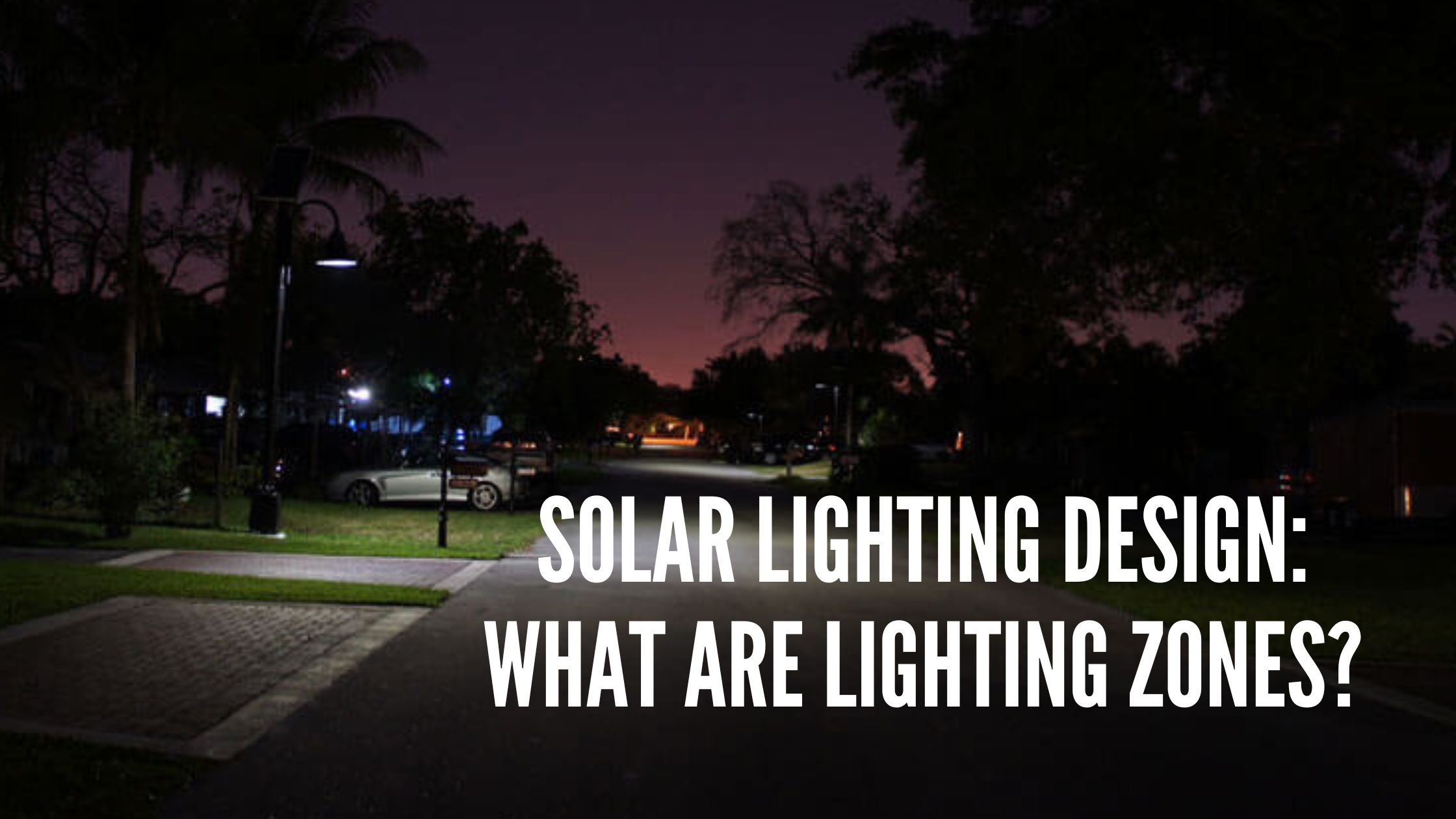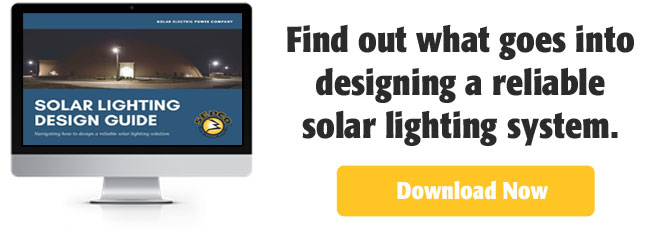Solar Lighting Design: What are lighting zones?

Contents
When designing outdoor lighting requirements, there is a factor that doesn't seem to get talked about much; lighting zones. These zones help determine how much light is required for a specific area. Ensuring you are illuminating the area per the lighting zone requirements will ensure that the lights you install fit and are not too bright or too dim.
These are broken up into five different zones; Lighting zone 0-4 and range from no ambient light to high ambient light. Areas with no ambient light benefit from much lower wattage fixtures, where high ambient light areas need much brighter fixtures to provide light. Understanding these lighting zone selections will make your lighting design fit within the scope and provide the necessary light to do the job.
LZ0: No ambient lighting
Areas where the natural environment will be seriously and adversely affected by lighting, such as parks, preserves, or undeveloped rural areas, are in LZ0 – lighting zone 0.
Lighting in these areas impacts the biological cycles of flora and fauna and can even distract from human enjoyment. Therefore, what little light is required in the residential areas near these locations should be extinguished when not needed.
When it comes to solar lights, lower wattage fixtures are used to provide illumination to the area. This lower wattage helps lower the solar requirements while providing the illumination needed. Custom controls also allow the lights to be reduced or turned completely off, lowering the solar requirement even more and reducing the impact on the natural environment.
LZ1: Low ambient lighting
Areas where lighting might adversely affect flora and fauna or disturb the character of the area, such as residential single- or two-family areas, agricultural zones, rural residential zones, business parks, and open spaces in developed areas, are in LZ1 – lighting zone 1.
In these areas, lower light levels are used for safety and security but are not always uniform or continuous. These lights can be extinguished or reduced when activity levels decline. For example, an HOA with random lights throughout the area has little or no care about where they are placed is a good example of a LZ1.
For solar lights used in these applications, lower wattages like in LZ0 are used, but they are typically operating all night, with part of the night being at a reduced output. There are exceptions to this, including business parks where there are shift changes or where people are present all night and areas with a higher crime rate where lighting is always necessary.
LZ2: Moderate ambient lighting
Areas of human activity where the vision of human residents and users is adapted to moderate light levels, such as neighborhood businesses, churches, schools, neighborhood recreation, or areas with modest nighttime uses, are in LZ2 – lighting zone 2.
In these areas, lighting is used for safety and security but is not always uniform or continuous. After curfew, these lights can also be extinguished or reduced when activity levels decline. For example, a local park may decide to have the lights reduced after the area closes, or most people leave, but then use motion sensors to come back to full when people are in the area.
Solar LED lighting systems start to get into higher wattages when people are more active and then reduce once people leave. In neighborhoods, the lights can be larger, like for intersections and along walkways, to provide added safety to pedestrians. However, these lights still offer plenty of illumination with fewer dark areas than lower ambient light areas.
LZ3: Moderately high ambient lighting
Areas of human activity where the vision of human residents and users is adapted to moderately high light levels, such as business districts, commercial spaces, or industrial and manufacturing zones, are in LZ3 – lighting zone 3.
In these areas, lighting is used for safety / security and convenience and is typically uniform and / or continuous. After curfew, these lights can also be extinguished or reduced when activity levels decline. These lights may also need active times during shift changes or other variables that happen at night.
With solar lighting setups, this is when having a complete lighting analysis completed by a lighting engineer is more important. This can show the light levels across a site to ensure plenty of illumination. This is also when the system may not reduce or turn off, providing continuous illumination throughout the night.
LZ4: High ambient lighting
Areas of human activity where the vision of human residents and users is adapted to high light levels, such as high-density entertainment districts or heavy industrial areas, are in LZ4 – lighting zone 4.
In these areas, lighting is considered necessary for safety, security and / or convenience, and it is mostly uniform and / or continuous. After curfew, lighting may be extinguished or reduced in some areas as activity levels decline. This is not used as a default zone, even though many people like to think that.
This is the highest end of illumination and sometimes outside the scope of solar for continuous operation, depending on the installation location. Lights in this range also require lighting studies, and should always ensure a good max to min ratio. The lighting should also match the area's ambient light, and higher wattages are used.
For example, in LZ0-1 we may use only a 10-15 Watt fixture for illuminating a pathway, 10' square sign space, or small area. In the same space in LZ3-4, we would be in the 20-30 Watt range to illuminate the same area, and larger scale projects are in the 50-75 Watt range. There could even be cases where more light output during busy times is required.
Understanding which zone your project fits within will ensure your lighting design is correct. Talk to your lighting designer to establish what lighting zone fits your project application best if you are unsure. This will help determine the lighting level and spacing requirements that fit best.
How to select your correct lighting zone
Next, let's address how to select a specific lighting zone for an area. Different areas fall into different lighting zones, and each has its own set of instructions for lighting design requirements. This will go over these different set of definitions and help understand what area fits into what lighting zone.
Lighting Zone Selection
Selecting a lighting zone can sometimes be as simple as understanding where the project fits best. Is it a remote residential application? Then probably LZ1 will work best. Is this a business in a business district with lots of ambient lighting? Then probably LZ3 fits best.
Speaking to the local permitting and building code office can sometimes help determine what lighting zone the project would fit into best. Pay attention to exemptions, waivers, relaxations, and "grandfathering," as well as long-term planning when determining the correct lighting zone.
Population Density
Different population densities fit into different lighting zones. For example, higher density areas are more likely to fit into LZ3 and LZ4, whereas lower density areas are in LZ1 and LZ2. Therefore, understanding the density of the place where lighting is required will help determine what lighting zone fits a project best.
Also, understanding curfews will help determine the correct lighting zone. For example, new York City (the city that never sleeps) will fit in LZ4 and have no dimming or off periods as there is no curfew or majorly reduced activity levels. In contrast, the suburbs around NYC would fit into a different lighting zone.
Community Priorities
Some communities are looking to make additional changes when implementing new lighting. Some of these changes include reducing light pollution, supporting or maintaining safety for pedestrians and the public, improving quality of life in neighborhoods, or reducing the impact on local wildlife are all things that communities may want to work on with new lighting projects.
Different lighting zones are meant for different applications, and understanding this will help determine which lighting zone the application fits in. Many light fixtures today can provide most of the changes no matter what wattage the fixture is, but paying attention to CRI and CCT is also important.
Atmospheric Priorities
Is the local community looking to reduce sky glow, limit glare, and diminish light trespass or conserve energy? When determining lighting zone and lighting requirements for new project installations, everything needs to be considered.
LZ0 and LZ1 should be used when covering large areas to reduce the impact on sky glow, whereas LZ2 through LZ4 can be used to reduce glare and light trespass as this is a local phenomenon and specific to the topography of the situation. There are two major exceptions: nearby observatories require less sky glow and prisons require brighter lighting.
Curfews
Is there a lighting curfew in place or one that is going to be put into place? This changes the lighting zone requirements and allows lighting to be turned off or reduced later. Lighting benefits are shown when people are present, but after the people all leave, the risk to the public is reduced, and the lighting can be reduced or eliminated. Exemptions include roadway lighting, some industrial areas, and lighting of public monuments.
Population Considerations
Some areas need different lighting due to the population requirements. For example, senior center areas need additional lighting to allow for better visibility but still need reduced glare. The lights may be able to reduce after a certain time but would need to provide adequate lighting if anyone were to enter the area.
Residential areas require lower lighting requirements, so sleep patterns are undisturbed; however, an industrial or manufacturing complex would need higher lighting requirements for visibility of people moving around the area, especially when operating heavy equipment. Understanding population requirements help determine if an adjustment to the lighting zone is appropriate.
Adjacent Zones
Adjacent zones need to be compatible with one another. Lighting zone 2 should be adjacent to either lighting zones 3 or 1. Too drastic of a change causes issues such as spillover and lowers security and visibility, especially along the borders. Like going outside after a movie, and it is still daytime – no one wants that.
Understanding these variances and exceptions to lighting zones will help better choose what lighting zone a project may fall into. This can significantly affect the requirements for a project and help determine what fits every project best.
Don't know what lighting zone you need to consider? Talk to your lighting specialist or your local municipality office. They would be able to provide you with the correct information or at least point you in the direction to find it.

